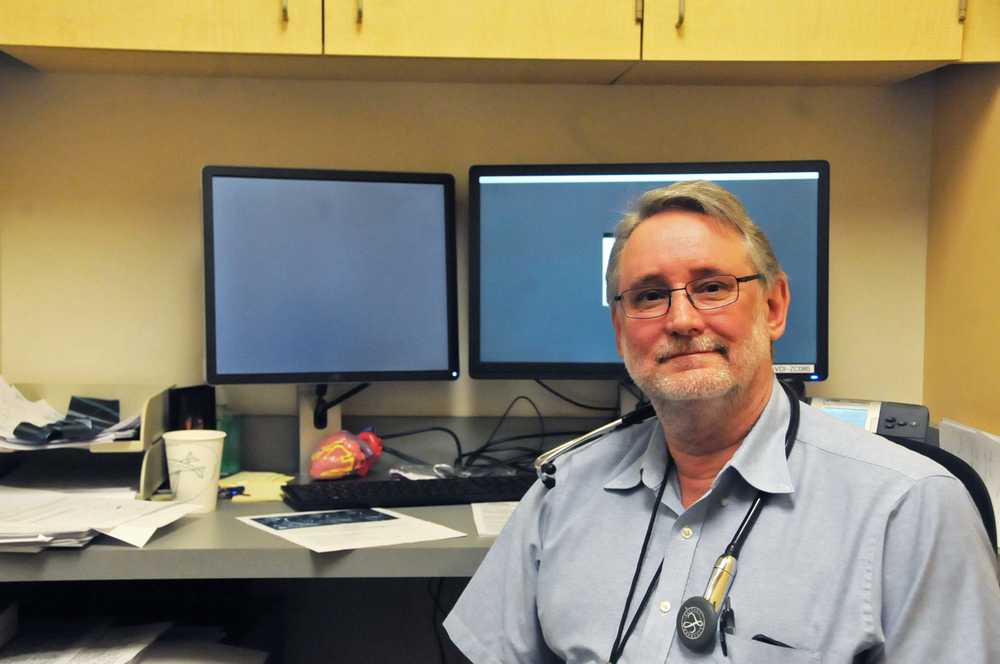Dickson, Tennessee never had its own cardiologist before Dr. David Chambers began practicing there in 1992.
Eight weeks ago, he became the only full-time cardiologist practicing in Soldotna.
Cardiologists have traveled periodically from the Alaska Heart and Vascular Institute in Anchorage to the hospitals in Soldotna and Homer, but now there will be a resident practitioner in the Central Peninsula Hospital specialty clinics building.
This isn’t Chambers’ first time in Alaska. In 2000, he worked in Anchorage for the Alaska Heart and Vascular Institute for a few years, but it didn’t stick. He moved back to Dickson to work in a multispecialty practice there.
“I loved Alaska, I just didn’t enjoy living in Anchorage,” Chambers said. “I’ve always lived in small towns, small communities.”
Chambers grew up in Dickson, a small town where he remembered “we used to go out to eat at the truck stop on the interstate because that was the only place to eat.”
He attended medical school in Mobile, Alabama and interned at Duke University Medical Center in Durham, North Carolina. He has also worked as a staff cardiologist at Horizon Medical Center in Dickson and an assistant professor at Vanderbilt University in Nashville, Tennessee.
He’s been connected to Alaska through a love of wildlife — he and his wife began coming to Alaska to watch the Iditarod years ago. For the last few years, they have come up every year to Homer and stayed on the Homer Spit, and then purchased a retirement home in Seldovia. He had retired from his practice in Dickson when someone from the Alaska Heart and Vascular Institute asked him if he’d like to practice in Soldotna.
“I said ‘Yeah, it gets me closer to Seldovia, and it starts that transition coming back up,’” Chambers said.
Working in small, rural communities comes with its own challenges, but Chambers said he expects there to be enough demand on the peninsula for the practice to expand in the future.
“I’ve been doing this 25 years, and I have some experience and enjoy working in small towns,” Chambers said. “I think the biggest challenge we’re going to face is meeting the needs of the hospital and meeting the needs of the community.”
During his time in Tennessee, he chaired the American Heart Association’s Cardiac Task Force for the state.
The task force’s job was to identify a more connected approach to cardiology in the state, gathering data from 22 hospitals to identify how best to treat patients who come in with heart conditions and how to improve their outcomes. He has also served on boards addressing needs in emergency medical services to help cardiac patients, such as equipping sheriff deputies with AED machines because they often reach cardiac patients before ambulances do.
Heart disease and stroke are the second and fourth leading causes of death in Alaska, according to the Alaska Division of Public Health.
The state developed a comprehensive plan to reduce heart disease and stroke in Alaska in 1998 and began getting funding from the Centers for Disease Control and Prevention in 2001 to address cardiovascular health.
The health care market in Alaska is challenging, with the Legislature approving a bill to chip in $55 million to subsidize affordable individual health insurance plans in the state to prevent a collapse of the market. Alaska’s average procedural costs are among the most expensive in the world and specialty care has been scarce outside of Anchorage, according to a 2014 report prepared by the Alaska Department of Health and Social Services.
Cardiovascular disease has been common on the central Kenai Peninsula as well — in 2012, 7 percent of adults in the area had some kind of heart disease, with more than a third reporting high blood pressure.
Rates of high blood pressure and high cholesterol also increased between 2004 and 2009, mostly occurring in adults younger than 45 years old, according to the 2013 Community Health Needs Assessment from Central Peninsula Hospital.
Cardiology services were identified as one of the top three needs in the Community Health Needs Assessment, along with cancer care and Alzheimer’s services.
The implementation plan aimed to increase the nursing staff and hospitalists’ cardiovascular capability, to reduce obesity as a risk factor and improve hypertension and cholesterol management in the community.
Chambers said the Soldotna medical community provides good care, Central Peninsula Hospital is forward-thinking about the future of the medical business and that he is looking forward to working with the medical community in the future, possibly bringing down cardiologists from Anchorage or elsewhere to further discussions about the practice of medicine.
“I think the medical community down here is fantastic,” Chambers said. “People have an impression that when they go to a rural community, the care is not going to be the same as it is in the big cities, but it is. A doctor is a doctor and if he’s well trained and he takes good care of people, it doesn’t matter whether he practices in Anchorage or in a small town.”
Reach Elizabeth Earl at elizabeth.earl@peninsulaclarion.com.

